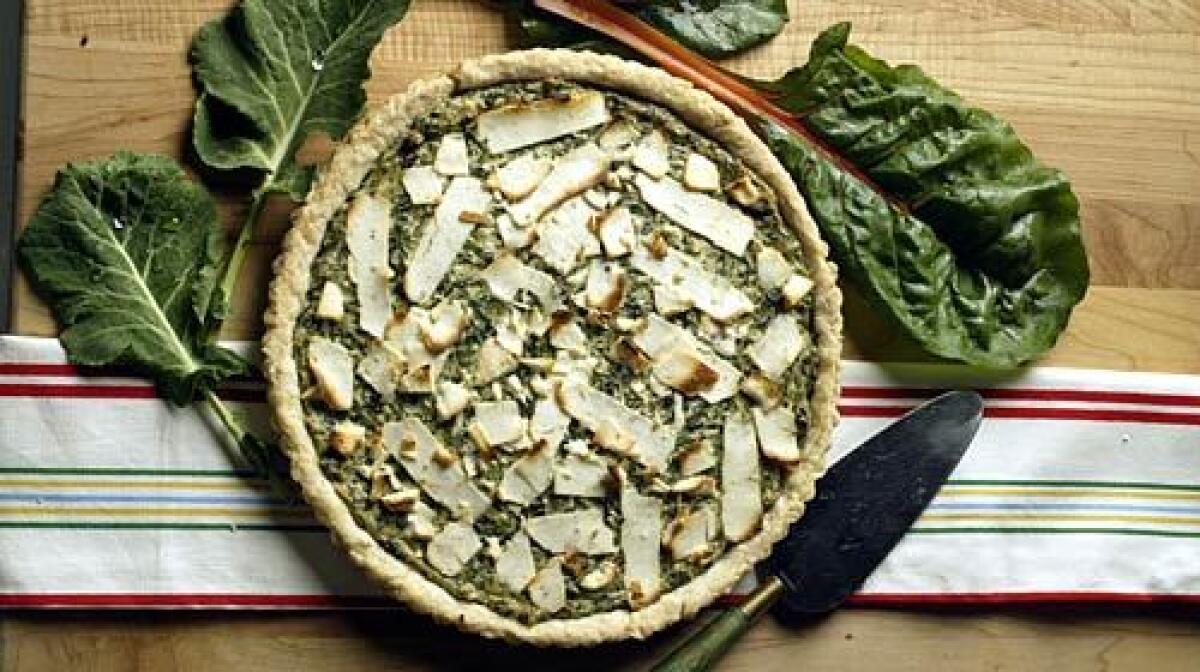The color of winter

- Share via
Some vegetables are born to be stars; others are best suited to ensemble roles. There is no better example of this than winter’s hardy cooking greens, a mainstay of farmers markets at this time of year.
While you can cook mustards, chards, collards, kale and even the leafy parts of turnips and beets individually, they are best prepared en masse, or as your momma might have said, “in a mess.”
Taken one at a time, each of these greens has something to recommend it. But cook them together and the result is extraordinary. The flavor of mixed greens is full and deep rather than sharp and pointed. Cook one type of green and you’ve got an oboe solo. Cook a mess and you’ve got an orchestra.
In the South, it’s traditional to simmer greens for a couple of hours with a good-sized chunk of fatty pork. This is the kind of perfectly realized rustic dish that -- if it had originated in, say, Liguria or Provence -- would now be offered in every upscale trattoria and bistro between Berkeley and Santa Monica.
But that’s hardly the only thing greens are good for. They make a great bed for cooking Italian sausage. Or you can add greens to your favorite soup or stew a few minutes before serving for a vibrant bit of color and texture. They are even surprisingly at home in elegant surroundings. Fold them into a souffle, for example, or bake them in a tart.
Moreover, I feel confident in reporting that greens are not only delicious; they have the power to heal. When I’m feeling beat-down, peckish, fluish or even just a little mulish, there is nothing that restores my equilibrium like a bowl of greens.
Greens go gourmet
“What is patriotism but the love of the good things we ate in our childhood?” Chinese author Lin Yutang famously observed, and the same could be said for tonics. I was raised in the South, and when I’m in need of sustenance, you can keep your chicken soup.
The appreciation of cooking greens seems to be spreading. It used to be that they could only be found in farmers markets, or the groceries in predominantly Southern neighborhoods. That’s no longer true. Last week I found mustard greens at my local upscale supermarket. What’s next? Gourmet bacon grease mixed in with all those extra-virgin olive oils?
And with the current trend toward pre-cut, “pre-prepared” produce, you can even find cellophane bags of cooking greens, packaged both separately and in mixed bunches, that have already been washed and chopped. These are not quite ready to cook -- a machine can never do as good a job at sorting and trimming out stems as a human can -- but they are still a convenience.
Though greens may be best in a collection, each variety is slightly different. And Southern cooks are pretty picky about the perfect ratio of one type to another. There is nothing haphazard about a well-prepared mess.
In fact, it sometimes pays to be still more careful. Even the most persnickety Southern cooks usually boil all of the greens in a mixture together, but for some dishes it’s a good idea to start them one at a time by blanching, particularly if you’re going to saute them afterward.
Blanch greens in a big pot of rapidly boiling salted water just until they wilt and become tender. Mustards will be done almost instantly. Kale will take three or four minutes. Chard leaves will take four or five (the stems will take five to seven). Collards can take nearly 10. Once they’ve been blanched, combine them to finish the cooking.
Blanching is only necessary when you want all of the greens to have the same texture. Sometimes that’s not desirable. In the ricotta tart, for example, the variety of textures is part of the attraction. Some of the greens are chewy; others are almost melting. In the soup, blanching isn’t necessary because the greens are shredded so fine in the food processor, that the differences in texture aren’t really noticeable.
In the recipe for greens with lemon oil, the leaves should be blanched before being sauteed. Not only is the dish best when everything is equally tender, but it also benefits because the initial cooking breaks down the cell structure of the leaf and allows it to absorb the aromatic oil.
Bright prospects
There is one more advantage to blanching. Greens are notorious for changing color, and not in a positive way. In the South, a good bowl would more accurately be called “olive drabs.” This happens because chlorophyll, the pigment that gives raw greens their vibrant color, is broken down by extended heating.
Blanching reduces the chances of this happening by softening the greens very quickly. This makes it easy to control the subsequent cooking so that it can be stopped as soon as you see this color shift begin to happen.
Perhaps paradoxically, before the color fades it first becomes much more intense. Time it just right, and you can end the blanching just at that moment, preferably by “shocking” the greens in an ice-water bath to stop the cooking cold. This brightening happens because the cooking drives off the air that is trapped in the leaf along with the chlorophyll. With the air gone, the color shines much more vividly.
On the other hand, some of the most memorable greens I’ve eaten were drab almost to the point of being beige. Remember, in an ensemble setting it’s more important to be interesting than pretty.
More to Read
Eat your way across L.A.
Get our weekly Tasting Notes newsletter for reviews, news and more.
You may occasionally receive promotional content from the Los Angeles Times.






